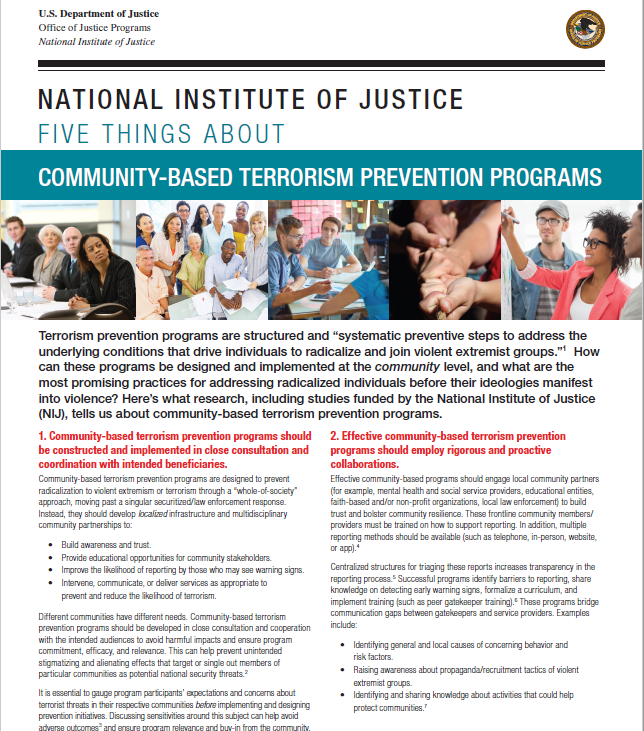Terrorism prevention programs are structured and “systematic preventive steps to address the underlying conditions that drive individuals to radicalize and join violent extremist groups.”[1] How can these programs be designed and implemented at the community level, and what are the most promising practices for addressing radicalized individuals before their ideologies manifest into violence? Here’s what research, including studies funded by the National Institute of Justice (NIJ), tells us about community-based terrorism prevention programs.
1. Community-based terrorism prevention programs should be constructed and implemented in close consultation and coordination with intended beneficiaries.
Community-based terrorism prevention programs are designed to prevent radicalization to violent extremism or terrorism through a “whole-of-society” approach, moving past a singular securitized/law enforcement response. Instead, they should develop localized infrastructure and multidisciplinary community partnerships to:
- Build awareness and trust.
- Provide educational opportunities for community stakeholders.
- Improve the likelihood of reporting by those who may see warning signs.
- Intervene, communicate, or deliver services as appropriate to prevent and reduce the likelihood of terrorism.
Different communities have different needs. Community-based terrorism prevention programs should be developed in close consultation and cooperation with the intended audiences to avoid harmful impacts and ensure program commitment, efficacy, and relevance. This can help prevent unintended stigmatizing and alienating effects that target or single out members of particular communities as potential national security threats.[2]
It is essential to gauge program participants’ expectations and concerns about terrorist threats in their respective communities before implementing and designing prevention initiatives. Discussing sensitivities around this subject can help avoid adverse outcomes3 and ensure program relevance and buy-in from the community.
2. Effective community-based terrorism prevention programs should employ rigorous and proactive collaborations.
Effective community-based programs should engage local community partners (for example, mental health and social service providers, educational entities, faith-based and/or non-profit organizations, local law enforcement) to build trust and bolster community resilience. These frontline community members/ providers must be trained on how to support reporting. In addition, multiple reporting methods should be available (such as telephone, in-person, website, or app).[4]
Centralized structures for triaging these reports increases transparency in the reporting process.[5] Successful programs identify barriers to reporting, share knowledge on detecting early warning signs, formalize a curriculum, and implement training (such as peer gatekeeper training).[6] These programs bridge communication gaps between gatekeepers and service providers. Examples include:
- Identifying general and local causes of concerning behavior and risk factors.
- Raising awareness about propaganda/recruitment tactics of violent extremist groups.
- Identifying and sharing knowledge about activities that could help protect communities.[7]
3. The impact of terrorism prevention programs can go beyond terrorism prevention itself.
Findings across NIJ-sponsored evaluations point to a potential for broader benefits and social outcomes from community-based terrorism prevention programs. These benefits range from personal skill-building to receiving valuable methods for dealing with non-terrorism-related interpersonal issues.[8] Beneficiaries of these efforts go beyond program participants and include law enforcement (better community relationships) and service providers (expanded social or professional networks), among others.
4. Including terrorism prevention in broader violence prevention and public health programming can be more successful than standalone terrorism-prevention programs.
Standalone programs, particularly primary prevention programs, designed to address violent extremism are unlikely to succeed if participants do not believe it is an issue in their community. Potential participants may find the idea that their community needs “violent extremism” programming insulting or stigmatizing.[9] Violence prevention, public health, and community resilience may be more acceptable program focus areas and, thus, a more viable way to include anti-extremism and anti-terrorism information as part of a broader framework.[10] However, program development and implementation teams should take care not to confuse participants or over-securitize public health frameworks. It is crucial to provide full transparency about covered topics to ensure trust between the program staff and participants.[11]
5. Understanding the efficacy, suitability, and impact of community-based terrorism prevention programs is key to achieving policy priorities and serving community needs.
Programs should be designed and developed with an evaluation component (through research and evaluation partnerships) to assess the efficacy, longterm impact, and potential changes in attitudes or behaviors associated with programming. It is vital to understand whether the program and its components are producing the desired outcomes. Still, even the best evaluations have limitations, including the inability to establish a treatment and control or comparison group, participants unexpectedly leaving the program,[12] or the inability to conduct randomized studies.[13] Evaluators, funders, and programs should coordinate to identify viable means of addressing these limitations and to design the most rigorous studies possible so the field can learn what works.
Learn more:
- Assessment of the State and Local Anti-Terrorism Training (SLATT) Program
- Evaluation of a Multi-Faceted, U.S. Community-Based, Muslim-Led CVE Program
- Engaging With Communities To Prevent Violent Extremism: A Review of the Obama Administration's CVE Initiative, Final Report
- Evaluability Assessment and Formative Review of the Community Resilience Exercises (CREX): Summary Overview
- Evaluating the Safe Spaces Program: Using a Community-Based Public Health Approach to Prevent Violent Extremism
- Evaluation of the Peer to Peer (P2P) Challenging Extremism Initiative
- Using Gatekeeper Training as a CVE Tool: Replication and Evaluation of a Gatekeeper Program in Prince George's County
- A Public Health Ethics Model of Countering Violent Extremism
Opinions or points of view expressed in this document represent a consensus of the authors and do not necessarily represent the official position, policies, terminology, or posture of the U.S. Department of Justice on domestic violent extremism. The content is not intended to create, does not create, and may not be relied upon to create any rights, substantive or procedural, enforceable at law by any party in any matter civil or criminal.


